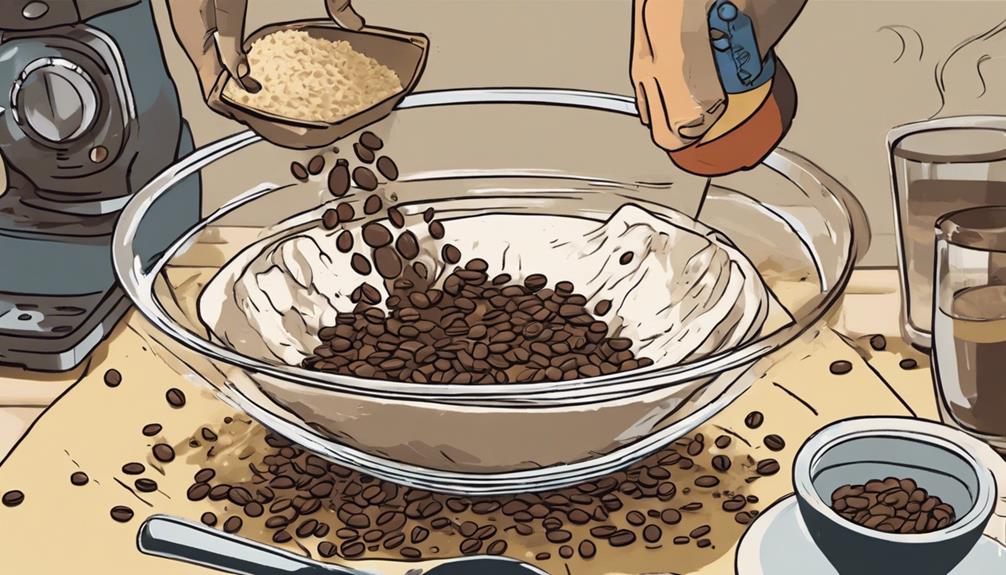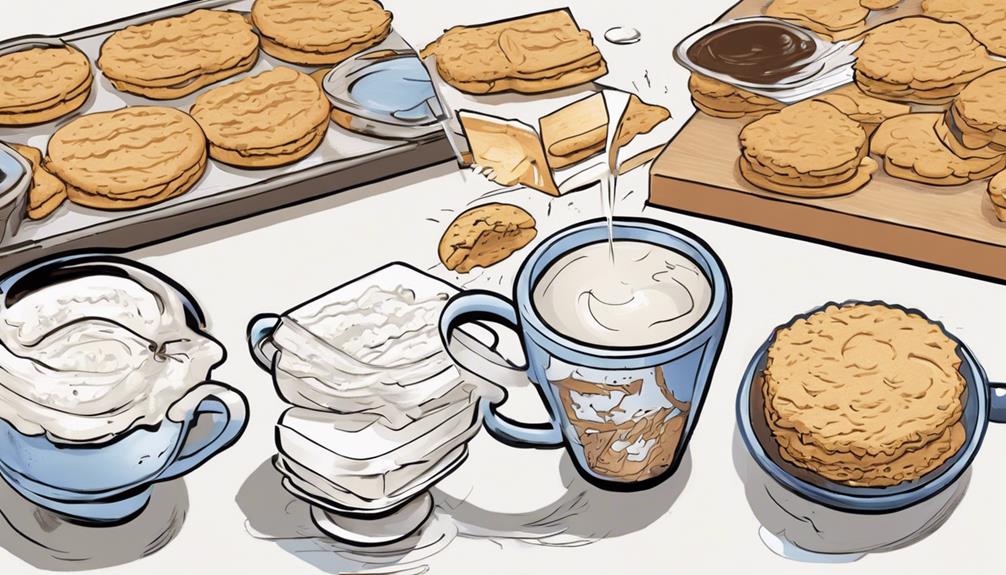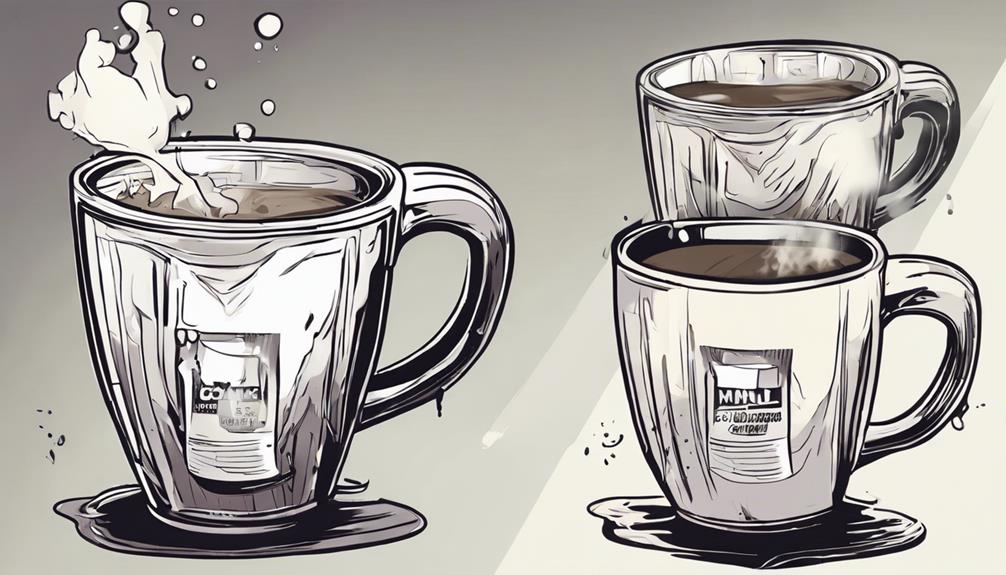Looking for a tasty snack to enjoy with your coffee? Give baking coffee biscuits a try! To begin, mix instant coffee with hot water and combine with your dry ingredients. Form the dough into balls, flatten them, and bake until they are a golden brown color. For the filling, melt butter, sugar, and golden syrup together, chill the dough, and add in some aromatic flavors. Once baked, allow the biscuits to cool and drizzle them with a glaze. Pair them with a cup of coffee for the ultimate treat. Broaden your snacking horizons with these delicious coffee biscuits.
Key Takeaways
- Gather ingredients and preheat oven for baking.
- Mix instant coffee with hot water to create a flavorful base.
- Shape dough into balls, flatten, and bake until golden brown.
- Prepare a rich filling with butter, sugar, and golden syrup.
- Drizzle baked biscuits with melted dark chocolate for added richness.
Recipe Details
To prepare the Coffee Biscuits recipe, start by gathering the necessary ingredients and preheating your oven to 160°C.
Begin by mixing instant coffee with hot water to create a concentrated coffee mixture. In a mixing bowl, combine this coffee mixture with the dry ingredients, which consist of flour, sugar, and baking soda. Mix everything until a uniform dough forms.
Next, shape the dough into small balls and place them on a baking sheet lined with parchment paper. Gently press down on each ball to flatten it slightly.
Once your oven reaches the desired temperature, bake the Coffee Biscuits for about 20 minutes or until they turn golden brown.
This recipe yields approximately 25 delicious cookies, perfect for sharing with friends or storing for later enjoyment.
The inclusion of instant coffee in the dough guarantees a rich coffee flavor without being overly sweet, making these biscuits a delightful treat for any coffee enthusiast.
Filling Preparation

You'll start by heating butter, sugar, and golden syrup to create a rich base for your filling.
Next, combine the wet mixture with the dry ingredients to establish a cohesive dough.
Remember to chill the dough overnight for the flavors to meld and the filling to set properly.
Heat Butter and Sugar
Begin by heating a mixture of butter, sugar, and golden syrup in a saucepan to create the base for the filling. This pivotal step not only melts the ingredients together but also develops a rich, caramel-like flavor for the filling.
The combination of butter and sugar forms a creamy and sweet foundation that sets the tone for the coffee biscuit filling.
Heating the butter and sugar allows them to blend seamlessly, creating a harmonious mixture that caramelizes beautifully. This process enhances the overall taste and texture of the filling, giving it a depth of flavor that complements the coffee notes in the biscuits.
The warmth from heating the butter and sugar is fundamental in creating a smooth and cohesive filling that will perfectly sandwich between the biscuit layers.
Combine Wet and Dry
Combine the heated butter, sugar, and golden syrup with coffee and vanilla extract to infuse the filling with aromatic flavors, forming a cohesive and flavorful base for the coffee biscuit filling.
Once the wet ingredients are well mixed, gradually add the dry ingredients to create a smooth dough. The coffee and vanilla extract will add a rich flavor to the mixture, enhancing the overall taste of the cookies.
As you blend the wet and dry components, make sure that the dough is evenly mixed to distribute the flavors throughout the filling. The combination of the coffee-infused wet ingredients with the dry components produces a balanced and delicious base for your coffee biscuits.
Chill Dough Overnight
Consider refrigerating the dough overnight to allow the flavors to meld and the texture to firm up, enhancing the overall taste and structure of your coffee biscuits. Chilling the dough overnight is an essential step in the process of making delicious coffee biscuits.
By giving the dough time to rest in the fridge, the flavors have the opportunity to meld together, creating a more harmonious taste profile. Additionally, the overnight chilling helps the dough firm up, making it easier to handle and shape before baking.
This process also allows the dough to relax, reducing the risk of excessive shrinking during baking. Ultimately, the result of chilling the dough overnight is a more tender and flavorful coffee biscuit.
Baking Process

You'll start by preheating the oven to 180°C to guarantee the coffee biscuits bake evenly.
Once baked, allow the biscuits to cool before drizzling them with a delicious glaze for added flavor.
Following these steps will result in perfectly baked coffee biscuits ready to be enjoyed.
Baking Temperature
Maintaining the oven at the recommended temperature of 180°C is crucial for baking perfect Coffee Biscuits. Before placing the Coffee Biscuits on the baking sheet, make sure your oven is preheated to the specified temperature. This step guarantees that the biscuits cook evenly and achieve a beautiful golden brown color.
When baking, place the baking sheet in the center of the oven to ensure even heat distribution. Remember to keep an eye on the baking time to prevent overcooking or undercooking the biscuits.
Once the Coffee Biscuits are baked to perfection, remove them from the oven and transfer them to a wire rack to cool. If you desire an extra touch of decadence, consider drizzling melted dark chocolate over the cooled biscuits. This adds a delightful richness to the already delicious Coffee Biscuits.
Cooling and Drizzling
After baking the Coffee Biscuits to perfection, the next step involves allowing them to cool before drizzling melted dark chocolate on top for an added touch of decadence. The cooling process is crucial as it sets the texture and flavors of the biscuits while preventing the chocolate from melting too quickly on the warm surface. This step also allows the biscuits to firm up, making them easier to handle when drizzling the chocolate. Not only does drizzling melted dark chocolate add a decadent finish, but it also creates a visually appealing element that enhances the overall presentation of the coffee biscuits.
| Cooling Step | Drizzling Step | Benefits |
|---|---|---|
| Allow cookies to cool | Drizzle melted dark chocolate | Sets texture and flavors |
| Prevents chocolate from melting too quickly | Adds decadent finish | Helps biscuits firm up |
| Makes biscuits easier to handle | Creates visually appealing element | Enhances presentation |
Filling Assembly

To achieve the desired aerated and paste-like texture, beat the cooled filling in a bowl before proceeding with the assembly process. Begin by transferring the filling to a bowl and then add an egg yolk to it. Using a hand mixer, blend together the filling and egg yolk until the mixture becomes light and fluffy. This step is essential to make sure that the filling will spread smoothly and evenly on the coffee biscuits.
Once the filling has reached the ideal texture, it's time to assemble the coffee biscuits. Start by piping the filling onto one cookie and then gently sandwich another cookie on top. Press down lightly to secure the filling between the two cookies. Repeat this process until all the cookies have been paired up and filled.
After assembling the cookies, allow them to cool on racks before serving.
The final step will be to enjoy these delicious coffee biscuits with a hot cup of your favorite coffee.
Serving and Enjoying

Start by arranging the coffee biscuits on a serving platter or individual plates to present them for enjoyment. Whether you're hosting a gathering or simply treating yourself, the way you present these tasty coffee treats can enhance the overall experience.
Coffee lovers will appreciate the effort you put into serving these delectable biscuits alongside a steaming cup of their favorite brew. The rich flavors of the biscuits perfectly complement the aromatic notes of coffee, creating a delightful pairing that's sure to satisfy your taste buds.
For an extra special touch, consider mixing things up by serving the coffee biscuits with chocolate pots or sprinkling them over a scoop of coffee ice cream. These creative combinations add a new dimension to the indulgence of enjoying these treats.
Feedback and Engagement

How can you enhance reader engagement and gather valuable feedback on your baking blog?
One effective way is to encourage your audience to share their experiences with the coffee biscuits recipe. Prompt them to try out the coffee mixture, brewed coffee, vanilla extract, and light brown sugar combination and leave comments on the taste and appearance.
Engage with your followers by responding to their feedback, whether it's positive comments or suggestions for more coffee-flavored recipes.
Additionally, consider hosting virtual baking parties where readers can join in, bake the coffee biscuits together, and share their results. By fostering a sense of community and appreciation for your supporters, you can create a space where interactions flourish.
Express gratitude for the support received and continue to invite feedback to strengthen the bond with your audience. Through these efforts, you can cultivate a loyal following that actively participates in your baking blog.
Frequently Asked Questions
How to Do the Biscuit Method in Baking?
To do the biscuit method in baking, start by cutting cold fat into dry ingredients for a crumbly texture. This technique creates air pockets, ensuring a flaky outcome. Distribute fat evenly for a consistent, light texture in your baked goods.
What Is the Trick to Making Biscuits?
To make biscuits, it's like sculpting with cold butter and flour, creating a crumbly masterpiece. Don't overwork the dough, chill it before baking, and guarantee the right temperature for golden perfection. Add espresso for a flavorful twist.
Why Do You Chill Biscuits Before Baking?
When you chill biscuits before baking, you solidify the fats in the dough, reducing spread. Cold dough holds shape, enhances flavors, relaxes gluten for tenderness, and makes handling easier. This process guarantees consistent, delicious biscuits every time.
Which Biscuits Are Best With Coffee?
For the best pairing with coffee, opt for rich and crumbly coffee biscuits. Their caramelly sweetness perfectly balances the bitterness of your brew. Customize with toppings like chopped walnuts or dark chocolate to elevate your snacking experience.
Conclusion
Now that you've mastered the art of baking coffee biscuits, get ready to enjoy the sweet satisfaction of indulging in these delicious treats. When you take that first bite and savor the rich flavor of the coffee combined with the sweetness of the biscuit, you won’t be able to help but smile from ear to ear. These coffee biscuits are the perfect accompaniment to your morning brew or as an afternoon pick-me-up. And if you really want to brighten someone’s day, share these treats with friends and family – a bright smile tips guaranteed!
Just remember, the best part of baking is sharing with others – or keeping them all for yourself, we won't judge!
So go ahead, brew a fresh pot of coffee, grab a biscuit or two, and savor the sweet taste of success.
Happy baking!









